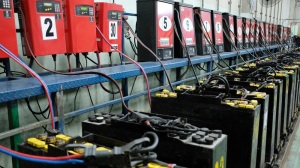Complete Powerpoint slide presentation for forklift instructors. Ready made training course
forklift battery charging station requirements explained
 This 2020 article is taken from the TCM website and gives a lot of useful advice about battery charging stations intended for forklift use.
This 2020 article is taken from the TCM website and gives a lot of useful advice about battery charging stations intended for forklift use.
When you’re operating heavy machinery on a daily basis, the risk of danger, injury or error is ever-present. The key to a hazard-free, fully functioning work environment is understanding the correct safety measures and operational requirements that you need to facilitate for your workforce. This is particularly important when it comes to electric forklift trucks.
Whilst there is a diverse range of forklifts available today, electric forklift trucks are becoming increasingly popular in material handling operations. Why? Because they have impressive economic and environmental benefits for businesses, including increased energy efficiency, lower fuel costs, ease of use, reduced CO2 emissions and a lower total cost of ownership.
Whether you’re running one electric forklift truck or an entire forklift fleet, your warehouse needs a designated forklift charging station. That means as with all types of heavy equipment use, companies need to ensure that those operating forklift trucks or working near them are safe. Companies who are keen to implement this technology in their warehouses must ensure they have a dedicated battery charging area fitted with the necessary safety features to meet forklift charging station power requirements.
Ensure correct fitting
Your charging points need to be fitted correctly. That means guaranteeing that your chargers are mounted in a way that is safe, secure and completely accessible.
To do this, you first need to locate an accessible area with a wall where the chargers can be securely mounted. For safety and compliance reasons, all chargers also must be fitted with emergency stop breakers to provide a way for the flow of electricity to be stopped immediately if or when needed.
Another important issue to factor in is hanging wires. Ensure chargers are mounted at the appropriate height and wires are no longer than a metre in length to avoid a significant tripping hazard for operators.
The final point to consider when assuring correct fitting for multiple units is space: leave at least a one-metre gap between each forklift truck. Doing so will make it so the vehicles are always accessible to operators.
Prevent warehouse damage
Fit acid resistant flooring to prevent damage to the warehouse floor. This is particularly significant when dealing with batteries as there are numerous ways that they can leak. From rare manufacturing defects or damage to the cell, releasing these hazardous chemicals can result in real damage to the immediate area as well as potential damage to your workforce operators.
This is entirely preventable by installing acid-resistant flooring.
In addition to protecting your warehouse, specialist flooring ensures that leaks are easier to clean up, which will save you time and money in the long run.
Being aware of charging station power requirements is key to operational success, but you need to stay informed about forklift servicing and maintenance too.
Access to safety equipment
Ensure safety equipment is easily accessible at all times. Forklift accidents can be fatal.
Basic safety equipment should be readily available in your charging station area, alongside more specialist equipment to protect your workforce in the event of an incident such as an accidental acid spill.
Take fire extinguishers, for example. A warehouse fire is a feasible threat that warrants the presence of a fire extinguisher. This piece of safety equipment should not only be easy to access, but it also needs to be suitable for use on electrical fires. Considering the safety and financial implications of a warehouse fire, installing a fire extinguisher is a small price to pay to protect the long-term wellbeing of your workforce and overall operations.
As electric forklift batteries are a potential burn hazard, forklift battery charging stations need to include a readily available emergency shower and eyewash station just in case an operator comes into contact with battery acid.
Along with preparing for and preventing workplace hazards, creating a culture of health and safety is key.
Provide adequate ventilation
Charging forklift batteries produces hydrogen gas, which is difficult to detect and extremely dangerous. That makes ventilating your charging area an essential part of operator safety.
Of course, it’s not enough to just open a couple of windows. To properly mitigate this, air quality should be frequently monitored to certify that hydrogen levels remain below 2% at all times.
Providing adequate ventilation to your workhouse is easy to achieve through building openings and exhaust fans. Nevertheless, ventilation is arguably one of the most vital safety features your charging station needs to provide and guarantee in order to keep your workforce safe.
Disclaimer. The legislative information contained on this web site is my interpretation of the law based on many years in the health and safety business. A definitive interpretation can only be given by the courts. I will therefore not be held responsible for any accident/incident/prosecution arising as a consequence of anyone using any information obtained from this web site.